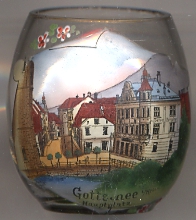

|
| SLOVENIJA | SLOVENIA |
| regija: Jugovzhodna Slovenija |
Kočevje (German: Gottschee, Italian: Cocevie) is situated at an elevation of 468 m on the river Rinža (Rinse) at the foot of the Kočevski Rog, a karstified plateau in the Kočevje Highlands above the Črmošnjice Valley. The plateau is part of the traditional Lower Carniola region of Slovenia and of the Dinaric Alps. Kočevje is the seat of the administration of the municipality of the same name, which has a population of about 17,000 (2009).
The area, known in German as Gottschee, was settled in the late 14th century by the Carinthian Counts of Ortenburg initially with colonists from the Ortenburg estates in Carinthia and Tyrol, and by other settlers who came from Austrian and German Dioceses of Salzburg, Brixen and Freising. The Gottschee ethnic and linguistic area consisted of more than 180 villages organized into 31 townships and parishes.
Gottschee was first mentioned in a 1363 deed. The settlement received market rights in 1377 and town privileges in 1471. In 1492, after the devastating period of the Turkish invasions, Emperor Friedrich III granted the citizens of Gottschee (like those of Reifnitz in Carinthia) the priviledge of peddling and thus many of the inhabitants began to work as travelling vendors of goods. During the Slovene peasant revolt of 1515 (Windischer Bauernkrieg) Gottschee was one of the centres of the revolt. In 1618 the barons Khisl purchased the domains and four years later they were elevated to counts. In 1641 the Auersperg counts obtained the domains. In 1791 the Auerspergs (since 1653 princes) were also given the title of dukes of Gottschee. The 'Unterkrainer Bahn' (Lower Carniola Railroad) was opened in 1893. With the foundation of the Kingdom of the Serbs, Croats and Slovenes in 1918, the Slovenian name Kočevje became the only official name of the town. The German grammar school, founded in 1872, was made a Slovene school and all German-speaking teachers and civil servants were dismissed. As a result, many ethnic Germans left the town; while the census of 1910 had shown a three quarters majority of German speaker, Germans were already a minority as of the census of 1921. When the Kingodom of Yugoslavia was occupied by German and Italy during World War II, Kočevje just like the Litoral and Ljubljana became part of the Italian occupation zone. As a result, most of the Germans that still lived in Kočevje were resettled to Lower Styria (today eastern Slovenia) and were given homesteads that originally had been owned by Slovenes and had been expelled by the German occupation forces. By the end of World War II the local region was largely depopulated and was resettled by settlers from Slovenia and other parts of Yugoslavia.

The  parish church of St. Bartholomew (cerkev sv. Jerneja) [left, no. 2754: the wall visible on the far left f the picture]
was built in 1901–1903 in Romanesque revival style and is one of the largest in Slovenia. The church replaced an older, Baroque, church of 1791. The architect
was Friedrich von Schmidt, who is best known for as architect of the Town Hall of Vienna.
parish church of St. Bartholomew (cerkev sv. Jerneja) [left, no. 2754: the wall visible on the far left f the picture]
was built in 1901–1903 in Romanesque revival style and is one of the largest in Slovenia. The church replaced an older, Baroque, church of 1791. The architect
was Friedrich von Schmidt, who is best known for as architect of the Town Hall of Vienna.
The building depicted on the right of the picture on glass no. 2754 is the
 store
store
[https://de.wikipedia.org/wiki/Kočevje, http://en.wikipedia.org/wiki/Kočevje,
http://wwwu.uni-klu.ac.at/hleustik/gottschee/archiv/zeitungen/gz/pdf_2006/maerz_2006.pdf,
http://rkd.situla.org/ (ref.nr.1564), http://www.kocevje.si/turizem-cerkve-sv-fabijan-bostjan-jernej, http://www.kocevje.si/turizem-kulturna-dediscina-cerkve,
http://en.wikipedia.org/wiki/Kočevski_Rog, https://de.wikipedia.org/wiki/Auersperg]
![[scale]](lineal.jpg)